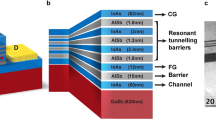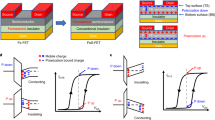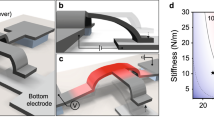Abstract
The silicon/silicon-dioxide system provides the cornerstone of integrated-circuit technology1. Since the introduction of devices based on this system, the (largely deleterious) effects on device operation of mobile and trapped charges in the oxide layer have been studied in great detail. Contamination by alkali ions, for example, was a major concern in the early days of metal-oxide-semiconductor device fabrication2. But not all SiO2 impurities are undesirable: the addition of hydrogen, for example, has the beneficial property of rendering charge traps inactive1. Here we show that mobile H+ ions introduced by annealing into the buried oxide layer of Si/SiO2/Si structures, rather than being detrimental, can form the basis of a non-volatile memory device. These mobile protons are confined to the oxide layer, and their space-charge distribution can be controlled and rapidly rearranged at room temperature by an applied electric field. Memory devices based on this effect are expected to be competitive with current state-of-the-art Si-based memories, with the additional advantage of simplicity—only a few standard processing steps are required.
This is a preview of subscription content, access via your institution
Access options
Subscribe to this journal
Receive 51 print issues and online access
$199.00 per year
only $3.90 per issue
Buy this article
- Purchase on Springer Link
- Instant access to full article PDF
Prices may be subject to local taxes which are calculated during checkout
Similar content being viewed by others
References
Sze, S. M. in Physics of Semiconductor Devices (Wiley, New York, 1981).
Snow, E. H., Grove, A. S., Deal, B. E. & Sah, C. T. Ion transport phenomena in insulating films. J. Appl. Phys. 36, 1664–1673 (1965).
Devine, R. A. B., Leray, J. -L. & Margail, J. Ultraviolet-radiation induced defect creation in buried SiO2 layers. Appl. Phys. Lett. 59, 2275–2277 (1991).
Vanheusden, K., Warren, W. L. & Devine, R. A. B. Incorporation of mobile H+ ions in SiO2 thin films by thermal annealing. J. Appl. Phys. (submitted).
Jayant Baliga, B. in Modern Power Devices 148–149 (Wiley, New York, 1987).
Elliott, S. R. in Physics of Amorphous Materials 245–247 (Longman Scientific & Technical, Harlow, 1990).
Hofstein, S. R. Proton and sodium transport in SiO2 films. IEEE Trans. Elect. Dev. ED-14, 749–759 (1967).
Winokur, P. S., Boesch, H. E., McGarrity, J. M. & McLean, F. B. Field- and time-dependent radiation effects at the SiO2/Si interface of hardened MOS capacitors. IEEE Trans. Nucl. Sci. NS-24, 2113–2118 (1977).
McLean, F. B. A framework for understanding radiation induced interface states in SiO2 MOS structures. IEEE Trans. Nucl. Sci. NS-27, 1651–1657 (1980).
Cristoloveanu, S. & Li, S. S. in Electrical Characterization of Silicon-on-Insulator Materials and Devices 104–111 (Kluwer Academic, Boston, MA, 1995).
Author information
Authors and Affiliations
Rights and permissions
About this article
Cite this article
Vanheusden, K., Warren, W., Devine, R. et al. Non-volatile memory device based on mobile protons in SiO2 thin films. Nature 386, 587–589 (1997). https://doi.org/10.1038/386587a0
Received:
Accepted:
Issue Date:
DOI: https://doi.org/10.1038/386587a0
This article is cited by
-
A Sputtered Silicon Oxide Electrolyte for High-Performance Thin-Film Transistors
Scientific Reports (2017)
-
Tunable D peak in gated graphene
Nano Research (2014)
-
Hydrogen-atom-mediated electrochemistry
Nature Communications (2013)
Comments
By submitting a comment you agree to abide by our Terms and Community Guidelines. If you find something abusive or that does not comply with our terms or guidelines please flag it as inappropriate.



